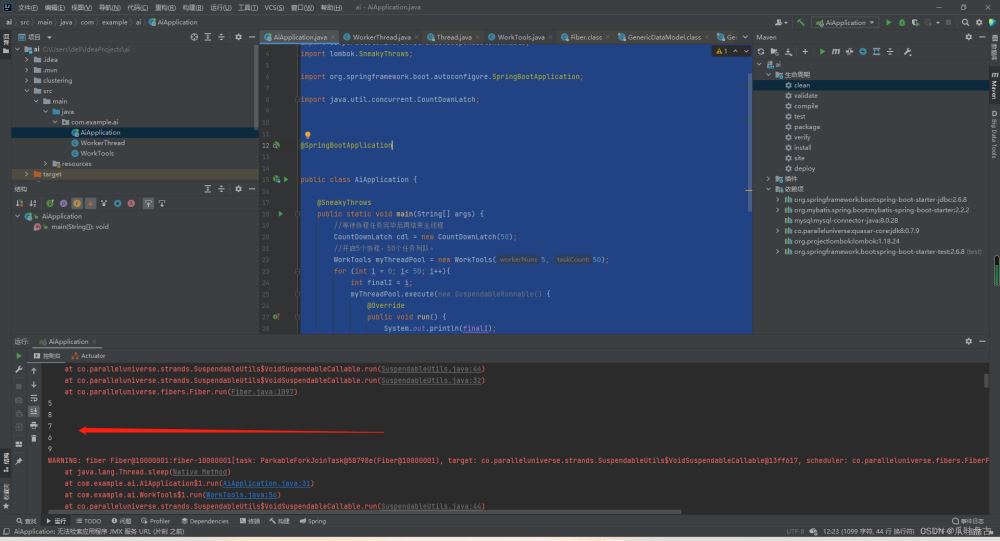java quasar协程池
爪哇盘古 人气:0业务场景:golang与swoole都拥抱了协程,在同任务并发数量下,协程可比线程多几倍。所以最近在查询java时了解java本身是没有协程的,但是某牛自行实现了协程,也就是本文的主角quasar(纤程)!在csdn中基本都是对它的基本使用,用法和线程差不多。不过没看到谁公开一下手写协程池的骚操作(谁会直接new它用?那是没挨过社会的毒打呀~)
一个线程可以多个协程,一个进程也可以单独拥有多个协程。
线程进程都是同步机制,而协程则是异步。
协程能保留上一次调用时的状态,每次过程重入时,就相当于进入上一次调用的状态。
线程是抢占式,而协程是非抢占式的,所以需要用户自己释放使用权来切换到其他协程,因此同一时间其实只有一个协程拥有运行权,相当于单线程的能力。
协程并不是取代线程, 而且抽象于线程之上, 线程是被分割的CPU资源, 协程是组织好的代码流程, 协程需要线程来承载运行, 线程是协程的资源, 但协程不会直接使用线程, 协程直接利用的是执行器(Interceptor), 执行器可以关联任意线程或线程池, 可以使当前线程, UI线程, 或新建新程.。
线程是协程的资源。协程通过Interceptor来间接使用线程这个资源。

废话不多说,直接上代码:
导入包:
<dependency>
<groupId>co.paralleluniverse</groupId>
<artifactId>quasar-core</artifactId>
<version>0.7.9</version>
<classifier>jdk8</classifier>
</dependency>
WorkTools工具类:
package com.example.ai;
import co.paralleluniverse.fibers.Fiber;
import co.paralleluniverse.fibers.SuspendExecution;
import co.paralleluniverse.strands.SuspendableRunnable;
import java.util.concurrent.ArrayBlockingQueue;
public class WorkTools {
//协程池中默认协程的个数为5
private static int WORK_NUM = 5;
//队列默认任务为100
private static int TASK_COUNT = 100;
//工做协程数组
private Fiber[] workThreads;
//等待队列
private final ArrayBlockingQueue<SuspendableRunnable> taskQueue;
//用户在构造这个协程池时,但愿启动的协程数
private final int workerNum;
//构造方法:建立具备默认协程个数的协程池
public WorkTools() {
this(WORK_NUM,TASK_COUNT);
}
//建立协程池,workNum为协程池中工做协程的个数
public WorkTools(int workerNum, int taskCount) {
if (workerNum <= 0) {
workerNum = WORK_NUM;
}
if (taskCount <= 0) {
taskCount = TASK_COUNT;
}
this.workerNum = workerNum;
taskQueue = new ArrayBlockingQueue(taskCount);
workThreads = new Fiber[workerNum];
for (int i = 0; i < workerNum; i++) {
int finalI = i;
workThreads[i] = new Fiber<>(new SuspendableRunnable() {
@Override
public void run() throws SuspendExecution, InterruptedException {
SuspendableRunnable runnable = null;
while (true){
try{
//取任务,没有则阻塞。
runnable = taskQueue.take();
}catch (Exception e){
System.out.println(e.getMessage());
}
//存在任务则运行。
if(runnable != null){
runnable.run();
}
runnable = null;
}
}
}); //new一个工做协程
workThreads[i].start(); //启动工做协程
}
Runtime.getRuntime().availableProcessors();
}
//执行任务,其实就是把任务加入任务队列,何时执行由协程池管理器决定
public void execute(SuspendableRunnable task) {
try {
taskQueue.put(task); //put:阻塞接口的插入
} catch (Exception e) {
// TODO: handle exception
System.out.println("阻塞");
}
}
//销毁协程池,该方法保证全部任务都完成的状况下才销毁全部协程,不然等待任务完成再销毁
public void destory() {
//工做协程中止工做,且置为null
System.out.println("ready close thread...");
for (int i = 0; i < workerNum; i++) {
workThreads[i] = null; //help gc
}
taskQueue.clear(); //清空等待队列
}
//覆盖toString方法,返回协程信息:工做协程个数和已完成任务个数
@Override
public String toString() {
return "WorkThread number:" + workerNum + " ==分割线== wait task number:" + taskQueue.size();
}
}测试代码:
package com.example.ai;
import co.paralleluniverse.strands.SuspendableRunnable;
import lombok.SneakyThrows;
import org.springframework.boot.autoconfigure.SpringBootApplication;
import java.util.concurrent.CountDownLatch;
@SpringBootApplication
public class AiApplication {
@SneakyThrows
public static void main(String[] args) {
//等待协程任务完毕后再结束主线程
CountDownLatch cdl = new CountDownLatch(50);
//开启5个协程,50个任务列队。
WorkTools myThreadPool = new WorkTools(5, 50);
for (int i = 0; i< 50; i++){
int finalI = i;
myThreadPool.execute(new SuspendableRunnable() {
@Override
public void run() {
System.out.println(finalI);
try {
//延迟1秒
Thread.sleep(1000);
cdl.countDown();
} catch (InterruptedException e) {
System.out.println("阻塞中");
}
}
});
}
//阻塞
cdl.await();
}
}
具体代码都有注释了,自行了解。我也是以线程池写法实现。
当前为解决问题:在协程阻塞过程中Fiber类会报阻塞警告,满脸懵逼啊,看着很讨厌。暂时没有办法处理,看各位大神谁有招下方评论提供给下思路。万分感谢~
加载全部内容